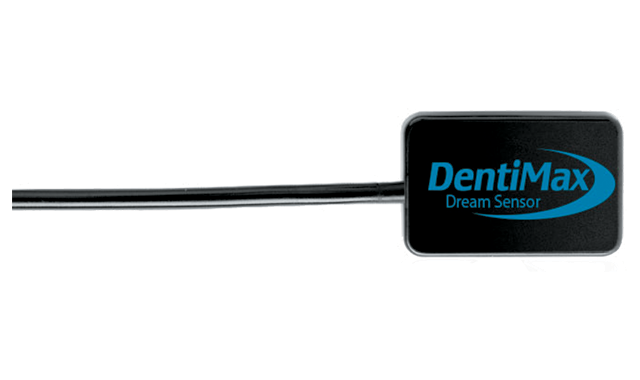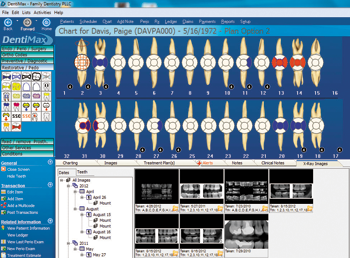An inside look at DentiMax software and digital sensors
How DentiMax’s complete system enables practices to become more efficient and detail-oriented.

DentiMax and its products were built from the notion that dentists deserved better quality products and higher quality service. DentiMax meets the needs of dentists with its practice management system, open platform digital imaging software and Dream Sensors. Additionally, DentiMax provides integrated benefits, making the clinical and financial areas of your office work better together.

“One of the founders is a programmer and the other was a sales manager and a dental practice manager,” says Alicia Dieujuste, DentiMax’s practice management director. “They saw a need in the market for easy, intuitive, affordable software and dental products to meet the needs of the dental practice. Basically, they saw what others were doing, mainly because of their experience in the dental and medical worlds, and the high cost of running their own dental practices, and thought that they could make their own software not only less expensive but better.”
Jim Ramey, managing director of DentiMax’s Digital Imaging Division, says that he wanted to fix the problems that he saw in the marketplace.
“I didn’t like what I saw,” Ramey recalls. “Dentists had a target on their backs and were getting taken advantage of - with everything that they have to buy, but specifically with digital sensors.”
Trending article: 8 ways to make your waiting room ‘the place to be’
Software
In an effort to help practices efficiently manage their patient workflows and day-to-day business operations, DentiMax offers its practice management software fully integrated with its Dream Sensors and digital imaging software.
“You can get a complete purchase all from one place, with our award-winning Dream Sensors, imaging software and practice management software,” Dieujuste says. “On a tactical level, there’s no other software that has this same ledger detail and financial information that we offer. The main purpose of a software solution is to help you collect your money, and there is no other system that does line item accounting and insurance management like we do. Our scheduler, also, is second to none.”
The software provides functions such as:
• Easy transmission of X-rays and other attachments
• Recording digital signatures
• Creating clinical notes
• Quick digital X-ray access
For Brittney Weinholtz, office manager at Fulmer Dentistry in Kenosha, Wisconsin, the software serves the clinicians’ needs, but also gives her the business detail that she requires.
“They have thought of every little, tiny detail, as far as what management would be looking for in a software system,” Weinholtz says. “With the clinical aspect of dentistry, they’re not digging deep into the software. They’re mostly scheduling appointments, entering information into the charts. When you’re looking at the management perspective of a dental software company, DentiMax has been great. I love the functions they have. It’s super easy to maneuver through. They have made it very easy to learn very quickly.”
For the digital imaging component of the software, Weinholtz praises the quality, especially the ability to send images to insurance companies.
“Jim has done a lot of fine-tuning to the imaging software,” Weinholtz says. “Those X-ray images come out so crisp and so clear. We haven’t had any issues regarding submitting X-rays to insurance. Our X-rays print out very clear. That’s always been a problem. If you don’t get a high-resolution X-ray taken, it’s hard to print them when you’re submitting them to insurance companies.”
The company’s software offerings are expanding with products allowing for faster, more efficient patient interactions.
“We recently released DentiMax Kiosk and Online Kiosk,” Dieujuste says. “Those items will help the staff with appointment confirmations, get people back into the office for recalls and do easy patient registration.”
More from the author: 10 easy ways to get CE credit
For practices that want to embrace a cloud-based solution versus a server-based solution, DentiMax also offers that option.
“We are happy to announce that we have a true cloud imaging software as well to complement our practice management software,” Dieujuste says. “So, offices can now exist totally on the cloud with us. And with our other new products, offices can be totally and truly paperless.”
“We have been offering a cloud solution for about four years that is equal to our server product, not a watered-down version,” Dieujuste says.
Sensors
On the hardware end are DentiMax’s award-winning digital sensors, the Dream Sensors. One of the biggest improvements in the world of digital sensors is the technology behind the sensors. When DentiMax began offering the Dream Sensors, most other manufacturers still used Charged Coupling Device (CCD) technology. DentiMax instead embraced Complementary Metal Oxide Semiconductor (CMOS) technology. Among other differences between the technologies, CMOS sensors are more efficient and less costly.
“All of the sensors out there were mainly CCD scintillators,” Ramey says. “The whole CMOS revolution hadn’t really hit the market. Their image was still marginal, when compared to film. I wanted something that was better than film, have the rounded, beveled corners, because almost all the other ones were square boxes. They were thick and bulky, so we came up with the Dream Sensors.”
Read more: How to simplify practice management with DentiMax
DentiMax imaging has continued to constantly look for ways to improve its sensors for clinics, which is why the sensors are durable and waterproof.
“It’s the original waterproof sensor,” Ramey says. “If it needs to be sterilized, if there’s a procedure where a barrier is compromised and blood or other bodily fluids get on the sensor itself, it can be soaked or rinsed off in a solution of glutaraldehyde or properly diluted CaviCide.”
The integration with DentiMax’s practice management software is a standout feature for Weinholtz.
“The nice thing about using the sensor with this software is it’s all built in one program,” she says. “A lot of times what you find in dental offices is you use one dental software company and then they’re using another imaging software company. When I am going to the patient’s chart, I can just connect right to their X-rays. I’m not logging out of my software system, going into a whole other system, having to add the patient into that system, and then take the X-ray. Instead, it’s all connected.”
Cabling is an important issue for sensors, and DentiMax has spent a lot of time and effort ensuring that theirs are durable and deliver a high-quality image.
“Our cable is super strong and it’s repairable,” Ramey says. “With every sensor out there, its weak point is where the cable enters the housing of the sensor. We have a Kevlar reinforcement right where the cable enters the housing. It adds strength, so when you need to bend the cable 90 degrees each way, you’re not hurting the sensor. In all the years we’ve been selling the sensor - eight years nowI’ve never had a cable fail where it enters the housing. Not once.”
DentiMax has offered three generations of the cable. The latest version offers durability and a lower signal-to-noise ratio, resulting in a better image.
“The improved signal helps with the image quality because the better signal you have means the better the resulting image can look,” Ramey says.
Service
DentiMax’s practice management system, digital imaging software and Dream Sensors can benefit any office.
“DentiMax is best suited for a range of offices and dental entities, anywhere from a single, independent dental hygienist to single practitioners and multi practitioners - we even have a dental school using our software and sensors,” Dieujuste says. “We pretty much have a platform to serve any type of practice, including specialties like oral surgeons, pedodontists, endodontists, periodontists - we even have some ortho practices using our software and loving it.”
Trending research: Can chewing gum be used to detect gum inflammation?
For Weinholtz, an important component is customer service.
“One of the most important things to me is that the staff at DentiMax is amazing,” she says. “It’s always super scary and nerve-racking anytime you’re switching over software. They always say it takes roughly a year for you to learn the depths of a new software program.
“Having a company like DentiMax that hires great employees that are knowledgeable of their system and are accessible every day to you is amazing,” Weinholtz continues. “I have questions all the time. We’ve had the system since January, and I still have questions. I know that I can email or call DentiMax, and I have created friendships and relationships with the people who are on the other end of the phone. I know, as an office manager, that that’s important, and I would expect that’s important for other people, as well.”
DentiMax continues to identify the needs of its clients and provide solutions, allowing practices to work more efficiently.